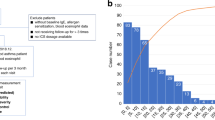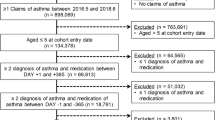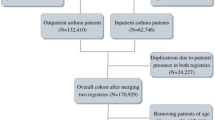Abstract
Background:
Although clinical and immunological studies have shown a possible link between allergy and idiopathic nephrotic syndrome (INS), the nature of the relationship remains unclear. Asthma is the most common chronic allergic airway inflammation. However, no study has used a longitudinal design with a population cohort to investigate INS in children with asthma.
Methods:
Using nationwide claims data from 2000 through 2007, we randomly selected 251,698 asthma cases and 1,006,791 frequency-matched controls. Incidence rates of INS and hazard ratios (HRs) were calculated.
Results:
The INS incidence was 3.36-fold greater in the asthma cohort than in the nonasthma control (9.26 vs. 2.76 per 100,000 person-years; 95% confidence interval (CI): 2.65–4.26). The HR for INS increased for those with more asthma-related medical visits per year, from 1.49 (95% CI: 1.06–2.11) for <3 visits to 15.7 (95% CI: 11.5–21.5) for ≥6 visits (trend test, P < 0.0001). The HR for INS slightly decreased during the follow-up period, from 3.41 (95% CI: 2.66–4.38) for ≤5.5 y to 2.90 (95% CI: 1.33–6.30) for >5.5 y.
Conclusion:
We conclude that children with asthma had an increased incidence rate of INS, and increased incidence rate correlated with asthma-related medical visits.
Similar content being viewed by others
Log in or create a free account to read this content
Gain free access to this article, as well as selected content from this journal and more on nature.com
or
References
Nephrotic syndrome in children: prediction of histopathology from clinical and laboratory characteristics at time of diagnosis. A report of the International Study of Kidney Disease in Children. Kidney Int 1978;13:159–65.
Hardwicke J, Soothill JF, Squire JR, Holti G. Nephrotic syndrome with pollen hypersensitivity. Lancet 1959;1:500–2.
Wittig HJ, Goldman AS. Nephrotic syndrome associated with inhaled allergens. Lancet 1970;1:542–3.
Reeves WG, Cameron JS, Johansson SG, Ogg CS, Peters DK, Weller RO. Seasonal nephrotic syndrome. Description and immunological findings. Clin Allergy 1975;5:121–37.
Meadow SR, Sarsfield JK. Steroid-responsive and nephrotic syndrome and allergy: clinical studies. Arch Dis Child 1981;56:509–16.
Meadow SR, Sarsfield JK, Scott DG, Rajah SM. Steroid-responsive nephrotic syndrome and allergy: immunological studies. Arch Dis Child 1981;56:517–24.
Rebien W, Müller-Wiefel DE, Wahn U, Schärer K. IgE mediated hypersensitivity in children with idiopathic nephrotic syndrome. Int J Pediatr Nephrol 1981;2:23–8.
Yap HK, Yip WC, Lee BW, et al. The incidence of atopy in steroid-responsive nephrotic syndrome: clinical and immunological parameters. Ann Allergy 1983;51:590–4.
Lin CY, Lee BH, Lin CC, Chen WP. A study of the relationship between childhood nephrotic syndrome and allergic diseases. Chest 1990;97:1408–11.
Florido JF, Díaz Pena JM, Belchi J, Estrada JL, García Ara MC, Ojeda JA. Nephrotic syndrome and respiratory allergy in childhood. J Investig Allergol Clin Immunol 1992;2:136–40.
Groshong T, Mendelson L, Mendoza S, Bazaral M, Hamburger R, Tune B. Serum IgE in patients with minimal-change nephrotic syndrome. J Pediatr 1973;83:767–71.
Schulte-Wissermann H, Görtz W, Straub E. IgE in patients with glomerulonephritis and minimal-change nephrotic syndrome. Eur J Pediatr 1979;131:105–11.
Lagrue G, Laurent J, Hirbec G, et al. Serum IgE in primary glomerular diseases. Nephron 1984;36:5–9.
Shu KH, Lian JD, Yang YF, Lu YS, Wang JY. Serum IgE in primary glomerular diseases and its clinical significance. Nephron 1988;49:24–8.
Mansfield LE, Trygstad CW, Ajugwo RE, Heiner DC. Serum concentrations of immunoglobulins E and G and alpha 2-macroglobulin in childhood renal disease. J Allergy Clin Immunol 1980;66:227–32.
Tain YL, Chen TY, Yang KD. Implication of serum IgE in childhood nephrotic syndrome. Pediatr Nephrol 2003;18:1211–5.
Hu JF, Liu YZ. Elevated serum IgE levels in children with nephrotic syndrome, a steroid-resistant sign? Nephron 1990;54:275.
Eddy AA, Symons JM. Nephrotic syndrome in childhood. Lancet 2003;362:629–39.
Cho BS, Yoon SR, Jang JY, Pyun KH, Lee CE. Up-regulation of interleukin-4 and CD23/FcepsilonRII in minimal change nephrotic syndrome. Pediatr Nephrol 1999;13:199–204.
Kimata H, Fujimoto M, Furusho K. Involvement of interleukin (IL)-13, but not IL-4, in spontaneous IgE and IgG4 production in nephrotic syndrome. Eur J Immunol 1995;25:1497–501.
Yap HK, Cheung W, Murugasu B, Sim SK, Seah CC, Jordan SC. Th1 and Th2 cytokine mRNA profiles in childhood nephrotic syndrome: evidence for increased IL-13 mRNA expression in relapse. J Am Soc Nephrol 1999;10:529–37.
Masoli M, Fabian D, Holt S, Beasley R ; Global Initiative for Asthma (GINA) Program. The global burden of asthma: executive summary of the GINA Dissemination Committee report. Allergy 2004;59:469–78.
McKinney PA, Feltbower RG, Brocklebank JT, Fitzpatrick MM. Time trends and ethnic patterns of childhood nephrotic syndrome in Yorkshire, UK. Pediatr Nephrol 2001;16:1040–4.
Stein RT, Martinez FD. Asthma phenotypes in childhood: lessons from an epidemiological approach. Paediatr Respir Rev 2004;5:155–61.
Sullivan SD, Rasouliyan L, Russo PA, Kamath T, Chipps BE ; TENOR Study Group. Extent, patterns, and burden of uncontrolled disease in severe or difficult-to-treat asthma. Allergy 2007;62:126–33.
Strachan DP. The role of environmental factors in asthma. Br Med Bull 2000;56:865–82.
Gerber MA, Paronetto F. IgE in glomeruli of patients with nephrotic syndrome. Lancet 1971;1:1097–9.
Galli SJ, Tsai M, Piliponsky AM. The development of allergic inflammation. Nature 2008;454:445–54.
Linsley PS, Clark EA, Ledbetter JA. T-cell antigen CD28 mediates adhesion with B cells by interacting with activation antigen B7/BB-1. Proc Natl Acad Sci USA 1990;87:5031–5.
Abbas AK, Sharpe AH. T-cell stimulation: an abundance of B7s. Nat Med 1999;5:1345–6.
Reiser J, Mundel P. Danger signaling by glomerular podocytes defines a novel function of inducible B7-1 in the pathogenesis of nephrotic syndrome. J Am Soc Nephrol 2004;15:2246–8.
Reiser J, von Gersdorff G, Loos M, et al. Induction of B7-1 in podocytes is associated with nephrotic syndrome. J Clin Invest 2004;113:1390–7.
Garin EH, Mu W, Arthur JM, et al. Urinary CD80 is elevated in minimal change disease but not in focal segmental glomerulosclerosis. Kidney Int 2010;78:296–302.
Garin EH, Diaz LN, Mu W, et al. Urinary CD80 excretion increases in idiopathic minimal-change disease. J Am Soc Nephrol 2009;20:260–6.
Ishimoto T, Cara-Fuentes G, Wang H, et al. Serum from minimal change patients in relapse increases CD80 expression in cultured podocytes. Pediatr Nephrol 2013;28:1803–12.
Ishimoto T, Shimada M, Gabriela G, et al. Toll-like receptor 3 ligand, polyIC, induces proteinuria and glomerular CD80, and increases urinary CD80 in mice. Nephrol Dial Transplant 2013;28:1439–46.
Chen YQ, Shi HZ. CD28/CTLA-4–CD80/CD86 and ICOS–B7RP-1 costimulatory pathway in bronchial asthma. Allergy 2006;61:15–26.
van Rijt LS, Vos N, Willart M, et al. Essential role of dendritic cell CD80/CD86 costimulation in the induction, but not reactivation, of TH2 effector responses in a mouse model of asthma. J Allergy Clin Immunol 2004;114:166–73.
Balbo P, Silvestri M, Rossi GA, Crimi E, Burastero SE. Differential role of CD80 and CD86 on alveolar macrophages in the presentation of allergen to T lymphocytes in asthma. Clin Exp Allergy 2001;31:625–36.
Wei CC, Yu IW, Lin HW, Tsai AC. Occurrence of infection among children with nephrotic syndrome during hospitalizations. Nephrology (Carlton) 2012;17:681–8.
Acknowledgements
C.-C.W. and T.-C.S. conceptualized and designed the study, drafted the manuscript, and approved the final manuscript as submitted. C.-L.L. conducted the initial analyses, reviewed and revised the manuscript, and approved the final manuscript as submitted. C.-C.W. and Y.-F.L. coordinated and supervised the data collection, critically reviewed the manuscript, and approved the final manuscript as submitted.
Author information
Authors and Affiliations
Corresponding author
PowerPoint slides
Rights and permissions
About this article
Cite this article
Wei, CC., Lin, CL., Shen, TC. et al. Risk of idiopathic nephrotic syndrome among children with asthma: a nationwide, population-based cohort study. Pediatr Res 78, 212–217 (2015). https://doi.org/10.1038/pr.2015.80
Received:
Accepted:
Published:
Issue date:
DOI: https://doi.org/10.1038/pr.2015.80
This article is cited by
-
Premature birth carries a higher risk of nephrotic syndrome: a cohort study
Scientific Reports (2021)
-
Nephrotisches Syndrom im Kindesalter
Monatsschrift Kinderheilkunde (2019)



